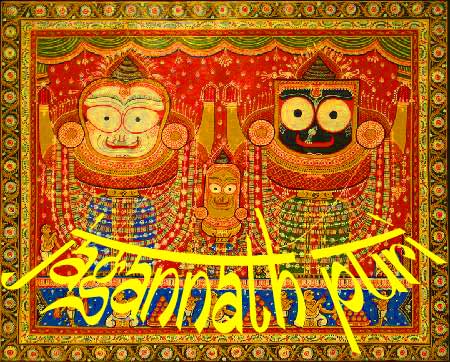
Jagannath Puri
The rishis of ancient India knew that a divine force pervaded every particle of the universe and this was the only force which could protect everything – whether it was an individual or a country. They did not depend on governments or military for their protection but had faith only in the divine. Hence from hoary times they established temples all over the sub-continent of India in order to protect the country from evil forces. Out of these four dhams or temples which were built in the four directions are renowned for being extremely holy. These are Badrinath in the north, set in the great Himalayan heights in the state of Garwal, Rameswaram in the south on the Gulf of Mannar which separates Sri Lanka from the mainland of India, Dwaraka in the west on the Arabian Sea in the state of Gujarat and Jagannath Puri in the east on the Bay of Bengal, in the state of Orissa.
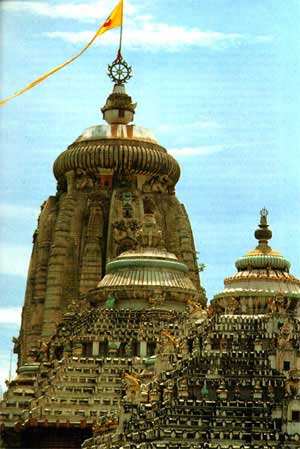
Home of Daru-Brahma Jagannath
Three of these great dhams are dedicated to Lord Vishnu and one to Lord Shiva. The Lord in his form as Shiva is continuously having ritual baths in the temple of Rameswaram, he then gets dressed and anointed in Dwaraka and then takes his food in Jagannath Puri and finally goes for tapasya in Badrinath. Time has been divided into four yugas or eons in Hinduism and each of these dhams are special to one of the yugas.
He was worshipped as Lord Narayana in the Satya Yuga in Badrinath, as Rama in the Treta Yuga in Rameswaram, as Krishna in the Dwapara Yuga in Dwaraka and as Daru-Brahma Jagannath in the present yuga of Kali at the Srikshetra in Puri.
Actually Puri is referred to by many names in the Puranas. This place was originally a hilly forest known as Nila, hence it was known as Nilachal, Niladri or Nilagiri. Since the site resembles a right oriented conch shell, it is also called Shanka Kshetra. It is also known as Purushottama Kshetra since Vishnu resides here as Purushottama, the perfect being.
Once in Dwarka, Lord Krishna's wives requested mother Rohini to narrate the divine
episodes of the Lord with the Gopis when He was in Vraj. Mother Rohini agreed but
considering it unbecoming of Subhadra to hear such episodes (Leela), she sent her
to guard the palace doorway. At that time Krishna and Balarama arrived at the
doorway. With arms wide apart, Subhadra sood between the two brothers - preventing
them from entering the palace. However, from where they stood, Rohini's katha soon
engrossed them all. Just then, sage Narada arrived. Seeing the three (Krishna,
Subhadra and Balarama) standing together like murtis, he humbly prayed: MAY THE
THREE OF YOU GRANT DARSHAN IN THIS MANNER FOREVER. The Lord granted
the boon. And the three eternally reside in the Jagannath Mandir in Puri.
Different stories are found in various Puranas describing the origin of this temple. The place was once a thickly wooded, hilly region inhabited by the tribe known as Savara. Their chief secretly worshipped the Lord in the form Nila Madhava or the blue Vishnu, in the heart of the forest. At that time in the city of Avanti there was a king called Indradyumna who was a great devotee of Vishnu. He was told in a dream that his Lord could be seen in his most perfect form in the state of Utkala (Orissa). The royal priest’s brother, Vidyapati was deputed to go to Orissa to find the deity and bring it back if possible. He went to the place described in the dream and found that Nila Madhava was the family deity of the chief of the Savaras, who were a local tribe. Their chieftain refused to divulge the secret place of worship to Vidyapati. The latter was not to be put off so easily and he continued to stay at the place and eventually married Lalita, the chief’s daughter. He begged her to intercede for him. The chief was unable to refuse his daughter’s pleas to show her husband the secret place. So he blindfolded his son-in-law and took him to a cave in the midst of a dense forest. Vidyapati very cleverly dropped mustard seeds along the way. These sprouted in a few days and he followed the sprouts and found his way to the secret cave. Inside he found an image of extraordinary luster made of a huge deep blue sapphire which he knew instantly to be the idol of Nila Madhava which the chief had been worshipping. He returned immediately and gave all the facts to Indradyumna. The king set out on a pilgrimage to Niladri but when he went to the cave he found that the idol of Nila Madhava had disappeared. The king was plunged in sorrow but again he had a dream in which he was told to perform an Ashwamedha Yaga (Horse Sacrifice) and then he would find a log of wood on the seashore from which he could carve an image. He did as commanded and found the log of wood floating on the sea.
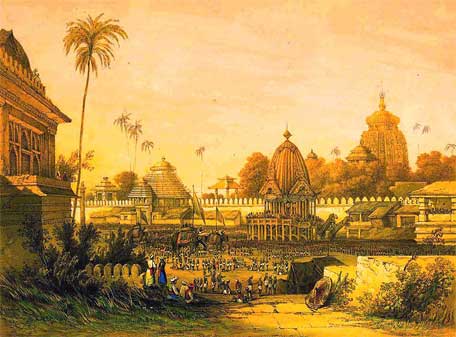
The king advertised for sculptors to find out the best person for the job. However none of them were able to do anything. The moment they put their chisel to the wood, the sharp portion became blunt. At last Vishwakarma, the architect of the gods appeared as an old man and offered to do the job. But he made the condition that he should be allowed to work unmolested for twenty one days inside a room with only the log of wood and that no one should disturb him before the stipulated period. For the first two weeks the sound of hammering and sawing could be heard but after that all sounds stopped and at the insistence of the queen, Gundicha, Indradyumna pushed open the door and found to his dismay that there was no trace of the sculptor. However he found three idols which were incomplete. They were fashioned only from the waist upwards. The hands of Jagannath and Balabhadra had not been completed and Subhadra had no hands at all.
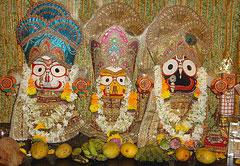
Jai Jagannatha!
The four-fold figures are aspects of the one and same principle. It is said that each one corresponds to one syllable of the word Ja-gan-na-tha. The king broke down and wept bitterly when he saw these unfinished idols but a divine voice advised him to make a temple for them and worship them as they were. He built a temple in the very centre of the conch shaped country. He then went to Brahma Loka to invite Brahma to install the deities. But a moment in Brahma’s world is an eon in ours so by the time he returned hundreds of years had passed and the temple had been buried under the sand. In the meantime another king had found the temple and claimed it as his own but the turtles in the tank that had been alive in Indradyumna’s time and the raven on the ageless banyan tree, bore witness that he was indeed the builder of the temple. Brahma believed them and installed the deities himself.
Of course that temple does not exist today. During the 12th century, Chodaganga Deva, the founder of the Ganga dynasty of Orissa started the construction of the temple of Jagannath which was later finished by his grandson. This has been recorded in the copper plates of the later Ganga kings. The images are of Krishna Jagannatha, his brother Balarama and his sister, Subhadra. There is also the image of Krishna’s weapon, Sudarshana which has been given no form and is just a pillar.
Jagannatha is regarded as Daru Brahman or the godhead as manifested in wood. His worship can be traced to the worship of trees by the Savaras. They normally used to lop off the unnecessary branches from a tree and worship only the trunk leaving two branches to represent the arms. On the top they would paint a human head. The idol of Jagannatha is a figure like this. His face is painted not carved. Trees have always been considered sacred by the Hindus. Even today the banyan tree and the peepul tree are worshipped in all parts of India.
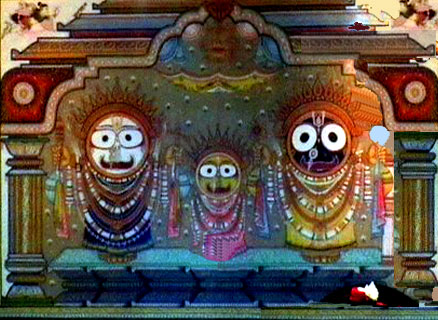
Jai Jagannatha!
There is nothing anthropomorphic about these idols. What is most attention catching are the eyes and the outstretched arms of the great saviour. Many poems have been written about the glory of these eyes and arms. The two eyes are supposed to represent the sun and moon, the cosmic sources of light, life and energy. With only two eyes dominating the appearance of all three of them, the holy triad seems to be a symbol of That Being who sees the whole creation at one sweep and from whom nothing can be hidden in all the worlds!
There is nothing sectarian about the cult of Jagannatha. He seems to have absorbed all other cults and sects into his ample fold. From the worship of God in the Totem pole to the worship of the Supreme Brahman in Vedanta can be found in the figure of Jagannatha. He includes all types of worship, starting from the primitive cult of tree worship, and the esoteric practices of Tantra, the meditative approach of Buddhism and the universal tolerance of the Jains and finally the all-comprehensive approach of Vedanta. In whatever form you think of Him, in that same form will He come to you. This is what Krishna states in the Gita and Jagannatha is a living emblem of this dictum. His daily rituals and festivals carry traces of Jaina, Buddhist, Shaivite and Vaishnavite traditions.
Everything in Puri is big. The main road leading to the temple is known as the Bada Danda or the grand road, the sea next to it is the Mahodadhi or the widest ocean, the prasad or food offered to the deities is called the Mahaprasad or the great prasad. Needless to say the deity himself is Jagannatha the Lord of the universe!
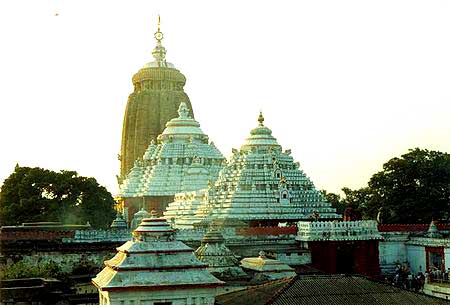
The temple also has the largest kitchen in the world and feeds thousands of devotees every day. The kitchen can prepare food for 100,000 people on a festival day and 25,000 is not unusual on a normal day. There are 36 traditional communities ('Chatisha Niyaga') who render specific hereditary service to the Deities. The temple has as many as 6,000 priests.
The temple is 65 metres high and stands on elevated ground so that it appears even larger. It can be seen from a long distance. The construction of the temple was begun by King Chora Ganda Deva and completed by his descendant Ananta Varman Chodaganda Deva in the 12th century.
On top of the temple is a chakra or wheel known as Nila chakra or the blue wheel. It is made out of eight types of metals. It is 11 feet 8 inches high and has a circumference of about 36 feet. A flag, fifty feet in length is tied every day on a mast attached to the Nila Chakra. On every 'Ekadasi' day a lamp is lit on top of the temple near the wheel. Only Hindus are allowed to enter the temple but it is said that those who cannot enter can have darshan of the 'Chakra' from outside, and they will get all the benefits of seeing the Deity. Even though it is a very hazardous climb up the walls of the temple to change the flag, to this day no accident has ever taken place which is one of the miracles attributed to this temple. Another is the fact that whatever the time of day, the huge 65 metre structure which encloses the deities never casts a shadow!
The temple complex comprises an area of 10.7 acres and is enclosed by two rectangular walls. The outer enclosure is called "Meghanada Prachira". The wall round this is 6m (20 feet) high. The inner enclosure is called "Kurmabedha". The walls were built during the 15th or 16th centuries. The main temple is surrounded by 30 different smaller temples. The "Narasimha temple" adjacent to the western side of the 'Mukti-Mandapa' is said to have been constructed even before the present temple.
The eastern gate is the man gate. In front of this is an 11m pillar, called "Aruna Stambha", so called because the figure on top of the pillar is Aruna, the charioteer of the Sun God. It used to be in front of the Sun Temple in Konark and was brought to Puri during the 18th century. When you enter this gate into the passage you will be struck by the huge face of Lord Jagannatha called "Patita Pavana" (Savior of the fallen). This Deity is visible from the road and is kept there so that non-Hindus can have 'Darshan' of the Lord.
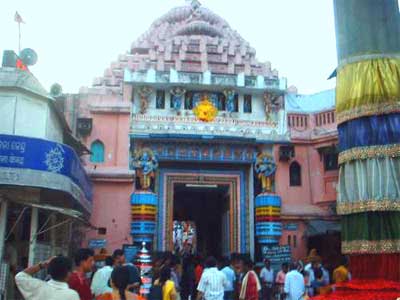
Eastern Gate
The temple has four gates- the Eastern "Singhadwara" (Lion Gate), which has been mentioned above, the Southern "Ashwadwara" (Horse Gate), the Western "Vyaghradwara" (Tiger Gate), and the Northern "Hastidwara" (Elephant Gate). There is a carving of each of these animals at the entrance of their respective gates. The Lion Gate, which is the main gate is the largest and is located on the Grand Road. From here one has to climb twenty-two steps to reach the inner courtyard. These steps have been sanctified by the countless devotees who have climbed up and great respect is given to them. If you take a right turn after climbing the steps you will come to the Ananda Bazaar, where the Mahaprasad is sold. If however you take a left turn at the top of the steps you reach the Kalpavata-or the thousand year old banyan tree. It is towards the south side of the temple and if you take a fruit from this and offer it at the foot of the tree, your wish will be fulfilled. For each wish you make you will have to renounce one favourite fruit for the duration of a year! Only then will your wish come true. Next you come to the Muktimandapa which is a 16-pillared hall known as "Brahmasava" (divine assembly). The temple of Bimala Devi (Vimala Devi) is found on the south-western corner of this enclosure. Sati’s foot is supposed to have dropped here so this is a siddha peeth. The goddess had occupied this spot long before the advent of Jagannatha. In fact he had to obtain her permission before he could occupy the place. She allowed him to do so, on condition that every bit of food offered to him should be re-offered to her. This condition is carried out to this day. Only after offering to her does it become Mahaprasad. Continuing along this way we come across many different shrines including one to Mahalakshmi.
If we approach from the western gate we come to the Niladri Vihar- which is an art gallery, showing the pastimes of Lord Jagannatha as well as the 12 incarnations of Lord Vishnu. Sona Kua or the Golden Well is near the northern gate. The water of this well is used to bathe Lord Jagannatha during "Snana-Yatra". Koila Vaikuntha is in the western portion of the temple between the outer and inner walls. It is approachable from the northern gate. This is the cremation ground of the deities. During 'Nava-Kalevara ceremony, the old images of Lord Jagannath, Baladeva, and Subhadra are buried here.
In the sanctum sanctorum are enthroned the idols of Balabhadra (white), Subhadra (yellow), and Jagannatha (black). They are seated on the "Ratna Simhasan" or throne of chlorite which is 16 feet long, 13feet wide and 4 feet high. Devotees can circumambulate the deities round this throne at specified times. The idol of Balabhadra is the tallest and is 6 feet high, Jagannatha is five feet and Subhadra is 4 feet. The emblem of Sudarshan is found next to Jagannatha. Facing this is the Mukhasala or the audience hall, which can be entered through three separate doors. The 'Kalaghata' door leads to the sanctum sanctorum. The southern door leads out of the temple and the northern to the 'Ratna Bhandar' (Treasury house).
In front of this is the Natya Mandira or the dance hall. This is a spacious hall, 21m (65 feet) in length and 20m (61 feet) wide. This is where the "Garuda Stambha" is located. When he was alive, Lord 'Chaitanya' used to regularly visit the Jagannatha Temple. However he always refrained from going inside the sanctum sanctorum and used to view the Lord from a distance from behind this column (Garuda Stambha). Apparently the first time he came for darshan of the Lord, he rushed inside in an ecstasy of devotion and fell senseless. Not knowing his greatness he was thrown out by the stupid attendants. Later on of course they realized their mistake and welcomed him with garlands from the deity. However every time he came near Jagannatha, tears would flow from his eyes and he would dance and sing in a paroxysm of delight and very often lose his senses. Ever after that he refused to face the Lord but always saw him from behind the Garuda Stambha. Behind this column is a small depression which encircles the pillar. It is said that Lord Chaitanya’s tears would often fill this depression. An impression of his hand is also found on the pillar. It is believed that the potency of a devotee's prayers to the Lord is doubled if he or she stands near this sacred pillar.
After this comes the Bhoga Mandap which is a spacious hall, 18m in length and 17m wide. There are sculptures and paintings about Lord Krishna's pastimes and other stories in this hall. This is where food offerings are made to the Lord.
For some centuries people were puzzled by the plain facade of this holiest of holy temples, and wondered why it was untouched by Orissa's rich sculptural heritage. The answer was found in 1975, when archaeologists first began removing the white plaster which covered the walls, and found that the sculpture underneath rivaled that of the other masterpieces of Orissan temple art. It is anybody’s guess as to why this plaster was put. One can only imagine that in the 18th century, the ruler decided that this would be the best way to protect the temple from the ravages of the salty sea air. Succeeding rulers continued the practice. As the old plaster was removed, renovation work was also taken up and broken stones and iron rods were replaced. Finally, a clear, thin coating is being applied to the entire structure, to preserve it for the centuries to come.
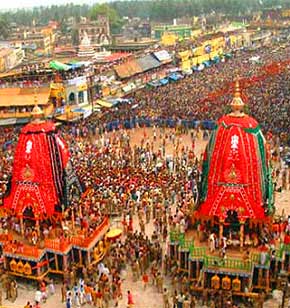
The temple conducts twelve yatras or processions annualy..
Even though the temple conducts twelve yatras or processions, the most important of these is the Ratha Yatra or the car festival. This is held on the 2nd day of the bright fortnight of Ashadh (June/July). It is meant to commemorate Lord Krishna’s journey from Gokula to Vrindavana. It is also an analogy of the journey of the jivatma along the grand trunk road of life in which it is helped by the compassion and mercy of the Lord.
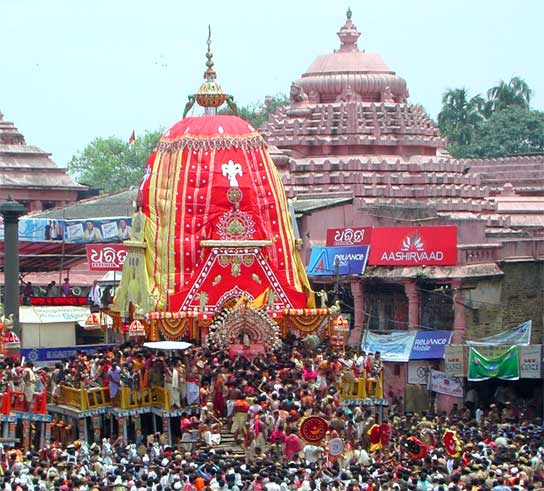
Ratha Yatra
The very first yatra is supposed to have been in the 3rd century when the king moved the images of the deities from Sundarachala to Nilachala. Now it has become a national and internationally acclaimed festival. Three huge chariots carry the three figures of the deities down the wide road leading from the temple. Sudarshan is kept in Subhadra’s chariot. The idols are taken to the temple of Gundicha where they stay for nine days after which they return. Jagannath’s chariot is 45 feet high, is covered in yellow cloth, and has sixteen wheels. These denote the sixteen kalas as calculated in Vedic mathematics. They also denote the sixteen divine tattvas or principles. Balabhadra’s chariot is 44 feet high and covered in blue cloth and has fourteen wheels which stand for the fourteen Manvantaras of each yuga. Subhadra’s chariot is black and has twelve wheels which stand for the twelve months. All three cars have four spirited wooden horses and an imposing image of a wooden charioteer . This festival gives all people, irrespective of caste or creed, a chance to have a vision of the Lord. As the Lord comes out of the gate, people are even allowed to touch Him. He who normally cannot even be glimpsed by the non-believers and untouchables now allows himself to be viewed and handled by all. At this time no distinction is made between Brahmin and outcaste. Everyone is equal in His eyes. He grants the wishes of all who approach him. The King himself is His slave. This fact is showed dramatically by the fact that the Raja of Puri sweeps the floor of the cars with a golden broom and sprinkles sandal powder on the floor after the idols are placed into the chariots. The descendents of the Savaras are in sole charge of the images. No priest is allowed to intervene between Him and His people who are allowed to embrace him freely as one does a brother. The idol of Sudarshan is brought out first and placed in Subhadra’s chariot. Balabhadra’s car is taken out first followed by Subhadra’s and then Jagannatha’s. The devotees draw the cars down the Great Grand Road, towards the Gundicha temple which is 3 kilometres away. The cars are very heavy and once they start it is virtually impossible to stop or turn them.
Gundicha was supposed to be the wife of King Indradyumna who had constructed the first temple of Jagannath. The Gundicha temple has four gates and two enclosures. The gates lead to an enclosure around the main shrine. The shape of this enclosure is supposed to resemble a tortoise. Many small temples are found in this enclosure. After staying here for nine days, the gods start their return journey. There are many ceremonies connected with this. The idol of Lord Jagannath is the last to re-enter the temple and His return marks the end of the festival. Many factors contribute to make this a unique type of car festival.
All the temples of Tamil Nadu in south India also hold elaborate chariot festivals but the chariot is normally beautifully carved and kept safely in a special shed and is used year after year. The chariots of Jagannath however are re-made every year. At the end of the season they are broken up and the wood is used for making religious articles. Normally all chariots will only have four wheels but these have a number of wheels which have to aligned very carefully so that the rims don’t touch the body and hinder the progress. They are huge structures and the English word “juggernaut’ has come from them.
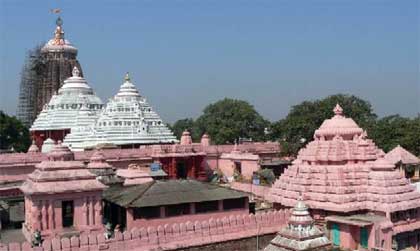
The temple has many unique features and very elaborate rituals. The most famous of these rituals concerns the re-making of the idols at different specified times decided by astronomical calculations.
The images are made from the margosa or neem wood which is actually a soft wood which can’t be expected to last forever. After an interval of many years there is a ceremony known as the Navakalevara or a renovation ceremony in which the three figures are changed and new ones installed. This happens only in those years in which the month of Ashada (June/July) comes twice. In the intervening years if some portions of the images are found to be decaying before the specified time, they are repaired. Navakalevaras were perfomed in 1863, 1893, 1912, 1931, 1950, 1977 and 1996.
In the specified year, on an auspicious day of the bright fortnight of the month of Chaitra (March/April), the Raja of Puri holds a meeting with the Rajaguru and Pundits and requests the Daita Sevaks to collect Daru (wood) for the new images. The Daitas receive flower garlands of the four deities and go to the palace of the Raja, who authorizes them and the carpenters to carve the images. They assemble at the Jagannath Vallabha Math and go to Kakatpur village (60 kms from Puri) without any fanfare. There they pray to the goddess Mangala to indicate the location of the suitable Neem trees for the purpose. The goddess instructs them though a dream and the Daitas go in search of the trees in batches. The log for Sudarshan is cut first, followed by those of Balabhadra, Subhadra and Jagannatha. There are certain signs by which the tree can be recognized. It should be a Neem tree with three, five or seven branches. It should not have a bird’s nest in it and an ant hill in which snakes reside should be at the foot of the tree. The trees should bear the marks of the conch, discus and so on. After locating the suitable trees a yaga for the forest is performed for three days. Then the trees are touched with axes made of gold and silver and then cut down with an iron axe. The trunks are then deported to Puri in newly made wooden carts. Before loading them, the logs are cut to the prescribed size and dressed and taken to the temple by the northern gate.
Carving of the new images starts from the day after Snan Purnima. On the 14th day of the dark fortnight the most important ceremony known as the transfer of Brahma is done very secretly. At midnight one of the old Daitas is chosen to transfer the Brahma from the old image to the new one. This Brahma is supposed to be the very soul of the deity and pulsates and throbs like a heart. No one can ever see or even feel it. It is located at the navel of each figure. The Daita is blindfolded and his hands are bandaged so that he cannot see or feel anything. He puts his hand into the navel and takes out the Brahma which has been wrapped in tulsi leaves. The miracle is that this tulsi which has been buried into the wood for so many years remains as fresh and fragrant as when it was put in. The Brahma is then wrapped in new tulsi leaves and placed into the navel of the new idol and covered. It is commonly said that the Daita who has performed this deed dies within the course of a year and attains liberation.
At the end of the Dwapara Yuga when Lord Krishna’s body was turned to ashes his navel was supposed to have been cast into the waters. This was later collected and this is the Brahma which was put into the navel portion of the idol of Jagannatha. After this transfer the old idols are buried in Koili Vaikunt. From the 14th day of the dark fortnight of the month of Ashad to the 9th day of the bright fortnight, different kinds of ointments are applied to the bodies of the images. The Daitas claim to be descendents of Lord Jagannatha and they observe mourning for 13 days in accordance with the Hindu custom. After that certain other rites are performed for the next fifteen days and the images are painted with the prescribed colours. Only then are the deities ready to be viewed by the devotees. Thousands of devotees flock to the temple to have this special darshan. Everything is completed two days before the Ratha Yatra.
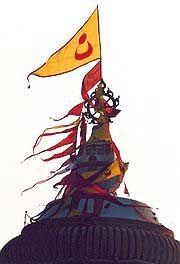
There are many miracles attributed to the temple which can be mentioned here. Every night food is kept inside the sanctum for the deities before the doors are closed and locked by the priests. Next morning there is no trace of this food when the doors are unlocked. Another fact which has already been mentioned is that the huge steeple of the main building never appears to throw a shadow whatever time of day and season it might be. Of course the fact that someone climbs up this structure every day and changes the flag is another miracle. No untoward accident has ever taken place till now. The miracle of the unfading tulsi leaves which wrap the Brahman has already been mentioned. Another strange thing is that even though a lot of food drops all over the inner courtyard when the bhog is distributed, not a single crow is ever seen to come down to peck at the particles of food. Of course another miracle is that countless pilgrims are fed daily at the temple. However many the numbers are, no one is ever left to go hungry.
After having described the history of this incredible temple, let me also recite my personal experience there. I had gone there about twenty years ago and then this December we decided to go as a family to have darshan of the Lord of the Universe. Now that I have described the best parts of the story of this temple, let me also disclose the unfortunate facts. The priests of this place who are known as “Pandas” have a great reputation for greed and avariciousness. The moment a hapless pilgrim comes out of the bus or car, one of these vultures will swoop on him and literally force him to go with him. On the pretext of showing him everything he will extract the maximum money from the poor pilgrim using every type of threat and even giving dire curses if his demands were not met with. He will insist that the deity can only be propitiated through him!
These Pandas loiter about all over the open space in front of the temple, in the bus and car parks and also inside the temple. Every small temple of the various deities has their own species of vultures hovering around ready to pounce on the unwary pilgrim. Unfortunately they are even seated right in front of the deities inside the sanctum sanctorum and insist that everyone who goes up to the throne has to put money in front of all the three deities if they want blessings. They also seem to get immense pleasure from catching hold of the heads of their victims and bashing them down in front of the deities with the dictum, “Banish your ego by banging your head in front of God!” Many of the poor pilgrims who have come from far off places do not seem to mind these indignities but others who come from so called better stations of life normally find this type of treatment to be really unbearable and unworthy of the priests who are supposed to be servitors of the Lord. Of course they are experts at gauging the quality of the pilgrim and know exactly how much they can fleece from each.
The first time we went into the temple was with the rest of the family and we were of course caught by a young Panda who was loitering about in the car park. We thought it better to have someone with us so that we would not be molested by the rest of the pack. He knew very little about the stories of the temple or perhaps did not think it worth his while to divulge these secrets to those who appeared to be quite tight fisted! Anyway though he promised to take us right inside we were only allowed to go to the audience hall in front of the deities from which one can only see Jagannath and Subhadra clearly. One has to get a ticket to go inside and our Panda dolefully told us that tickets were not available at that time. However we were quite happy to view Him from outside. Here also there are Pandas who kept pointing to their plates and asking for dakshina (money). We managed to get off lightly by paying Rs.10 each but somehow the whole affair left us with a feeling of unhappiness that these greedy people should be guarding the gateway to the Lord’s abode. The fellow accompanying us also gave us a lot of false information about the various deities.
The next morning I made a sudden decision and decided to go for the 6 am darshan, by myself. The whole front part of the temple right up to about 15 metres is forbidden to vehicles since they don’t want any clutter in front. One can take the car to the park and then get on to mini buses which drop you close to the east gate. However since I was pressed for time I asked the driver if he could avoid the policemen who directed cars to the car park and make a detour through the alleys at the back. Since it was a small car he managed to squeeze between the narrow lanes and I was able to get off very near to the east gate. I was all prepared to be accosted by one of the Panda clan but to my amazement no one stopped me from entering the huge door. I was not even checked for cell phones etc by the police woman standing there. She simply looked through me as if I did not exist. I walked in as if I was totally invisible. This phenomenon went on throughout my visit. I saw a little queue standing on the side outside the sanctum and was told that I had to get a ticket if I wanted to get inside. I ran and bought a ticket and waited expectantly till they started to let us in. Just before passing the last barrier there was the usual mad rush and I found myself propelled into the huge room which houses the deities. There were slippery steps leading down and I would surely have fallen had it not been for the crowd which held me up. It was only when I got into the actual sanctum that I looked up and was really struck by the size of the deities in front. Since the room was lower than the audience hall, their full size could not be ascertained from outside. I felt quite weak and dizzy by this enormous explosion of divine power which emanated from the Lord. The room was jam packed with people and I would surely have fallen if I had been alone. Tears poured unheeded down my cheeks as I gazed at Him. I could only see His huge, round eyes which seemed to be boring into the very depths of my soul. Raising both my hands above my head in a gesture of total surrender I shouted “Govinda”, “Govinda”, in a frenzy of delight and begged Him to support me so that I could witness whatever ritual was going to take place. I had no idea what was going on but I knew that the crowd was waiting expectantly for something. I also knew that without divine support I would surely faint. Somehow I was pushed towards the wall which supported me. The air was so heavy that I could hardly breathe. I felt as if I was being suffocated and cried out to Him to save me from the ocean of samsara which was threatening to engulf me. Tears were pouring unchecked down my cheeks and all I could see in front was a blaze of lights through which His huge eyes were boring into me like a drill, noting every single thing about me from the time I was born and even before that, to the many lifetimes I had passed through.
“Samsara sagare madhye deenam mam karunanidhe,
Karma graham griheetangam,
Mam uddwara bhavarnavat.”
“O Thou store house of compassion,
Do Thou liberate me.
From this ocean of transmigratory existence,
In which I am drowning, bound as I am by my own karmas.”
At that moment I was quite unaware of myself or what I was doing or saying. It was as if I was being propelled to act by an unseen force which was squeezing the life or perhaps the ego out of me and at the same time supporting me and comforting me. Then I became aware that the arati was going on and everyone was surging forward to take it. I could not move, mesmerized by the eyes which were goring into me. Suddenly in front of me there appeared a small, wizened up little man who thrust some tulsi leaves into my hand. He was so small that I had to bend down to thank him and suddenly I felt him thrust his two fingers into both my eyes and press some camphor into them. It was only later that I was told the significance of this act. Apparently it was a great blessing to have camphor put into the eyes. This was especially significant for me since I had just had my eyes operated for cataract.
I looked round for the little man to give him some dakshina but he had vanished. Then I realized that the crowd was slowly thinning since people were going out after the arati. I too went forward in a daze, not really knowing what I was doing. No Panda touched me and no one seemed to notice when I pressed my head on the throne in front of Jagannatha. I realized then that people were circumambulating the throne so I too went round, running my hands all over the dais since the passage was very narrow and in my state I felt I might have fallen down. Again I realized later that this was the right thing to have done. I did another round before leaving the hall. I left reluctantly, loathe to leave His presence. I cannot remember the rest of that visit since I felt I was in a kind of trance and didn’t really know how I returned home.
That evening when the rest of the party was shopping in the bazaar outside I opted to go for another darshan. When I went round the inner courtyard I saw a big crowd standing on the northern side looking up expectantly. When I asked what the matter was, I was told that this was the time when the flag was being changed. High above near the chakra, I saw two figures. One was standing below the chakra and held the pennon which he passed to the other person who was above him. I watched fascinated as the change was affected. Slowly and easily the two figures started to come down. I realized that this was the reason that I had been compelled to go to the temple at that time. The miraculous occurrence which I had just witnessed did not strike me till I got home. To climb a 62 foot spire with no support or hand rail was surely a remarkable feat. There were no steps. Instead they used the formations on the spire as footholds. Just looking at it made me feel giddy.
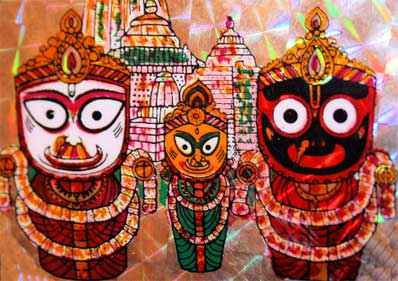
Jai Jagannatha!
Next morning I went again at 6 am. This time I was in a big car and the driver did not think that he would be able to manipulate the narrow alleys. I was desperate to go as fast as possible so I told him to proceed along the Grand Road. He told me that it would be better for me to get down at the car park and take an auto or rickshaw since there was no way by which the police would allow us to pass. I told him to proceed. When we reached the policeman the driver got out and there was some talk between them. Not waiting for more I jumped out and talked to the policeman myself and by His grace he allowed us to proceed. There was another policeman on the same road and I followed the same procedure and he also waved us on!! On the return journey we sailed along the completely empty Grand Road with not a single person to stop us. It was incredible. In the meantime my son and daughter-in-law had also come for darshan after I left the hotel. They had stopped their car in the car park and were coming in a rickshaw and they said they were dumbfounded to see me sailing by in state in that big car on that royal road – the state road made for His Highness the Lord of the Universe!
What can I say about the rest of my stay? Never once was I stopped or harassed by the Pandas and twice I had the experience of someone thrusting camphor dust into my eyes. I was so busy drying my eyes that I never got a chance to see the person who had done this. On our last day the whole family went for darshan. We had a very good Panda to help us and though he took us right inside and showed us many things, I have to admit that this did not in any way measure up to the various darshans and near miraculous experiences that I had when I went alone.
All Hail to Jagannatha! Lord of the Universe! May His blessings be showered on the whole world and in particular to all those who happen to read this.
Jai Jagannatha!
About Vanamali Ashram |
Ashram Store |
Satsang |
Miracle at Vanamali |
Home |
Sons of Shiva |
Reason For Rebirth |
Vanamali Love Songs |
 |
||||||
|





